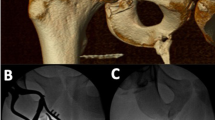Abstract
Objective
To retrospectively evaluate neurogenic heterotopic ossification in an early neurological rehabilitation population (phases B and C) with respect to epidemiology and morphology on conventional radiographs.
Materials and methods
Over a 4-year period, 1,463 patients treated at a clinic for early neurological rehabilitation were evaluated for clinical symptoms of neurogenic heterotopic ossification. In case of clinical suspicion, plain radiographs of the expected sites were obtained. If heterotopic ossification was detected, the initial and subsequent radiographs were retrospectively analyzed for sites, size, and morphology. Immature lesions were categorized as small (<10 mm) or large (10–100 mm).
Results
The prevalence rate of neurogenic heterotopic ossification was 2.05%. The condition was most common in young male adults. The hip was the most common site accounting for more than half of the cases. Two or more ossifications were seen in 56.7% of the affected patients with approximately two-thirds showing bilateral symmetric involvement of corresponding joint regions. The size of ossifications strongly varied interindividually. Small immature lesions demonstrated less progression in size than large lesions during maturation (P < 0.05).
Conclusion
Standard radiographs, as a fast and inexpensive technique, allow the expected size progression of heterotopic ossifications during maturation to be estimated, which is relevant in terms of therapeutic decisions, patient mobilization, and neurological rehabilitation.

Similar content being viewed by others
References
Guo JJ, Yang HL, Cheung KM, Tang TS, Luk KD. Classification and management of the tandem ossification of the posterior longitudinal ligament and flaval ligament. Chin Med J Engl. 2009;122:219–24.
Richards PJ, Braid JC, Carmont MR, Maffulli N. Achilles tendon ossification: pathology, imaging and aetiology. Disabil Rehabil. 2008;30:1651–65.
Ahrengart L. Periarticular heterotopic ossification after total hip arthroplasty. Risk factors and consequences. Clin Orthop Relat Res 1991;263:49–58.
Garland DE. Clinical observations on fractures and heterotopic ossification in the spinal cord and traumatic brain injured populations. Clin Orthop Relat Res 1988;233:86–101.
Wittenberg RH, Peschke U, Botel U. Heterotopic ossification after spinal cord injury. Epidemiology and risk factors. J Bone Joint Surg Br. 1992;74:215–8.
Cipriano CA, Pill SG, Keenan MA. Heterotopic ossification following traumatic brain injury and spinal cord injury. J Am Acad Orthop Surg. 2009;17:689–97.
Taly AB, Nair KP, Jayakumar PN, et al. Neurogenic heterotopic ossification: a diagnostic and therapeutic challenge in neurorehabilitation. Neurol India. 2001;49:37–40.
Goldberg MA, Schumacher HR. Heterotopic ossification mimicking acute arthritis after neurologic catastrophes. Arch Intern Med. 1977;137:619–21.
Orzel JA, Rudd TG. Heterotopic bone formation: clinical, laboratory, and imaging correlation. J Nucl Med. 1985;26:125–32.
Ragone Jr DJ, Kellerman WC, Bonner Jr FJ. Heterotopic ossification masquerading as deep venous thrombosis in head-injured adult: complications of anticoagulation. Arch Phys Med Rehabil. 1986;67:339–41.
Sarafis KA, Karatzas GD, Yotis CL. Ankylosed hips caused by heterotopic ossification after traumatic brain injury: a difficult problem. J Trauma. 1999;46:104–9.
Wharton GW, Morgan TH. Ankylosis in the paralyzed patient. J Bone Joint Surg Am. 1970;52:105–12.
Garland DE. A clinical perspective on common forms of acquired heterotopic ossification. Clin Orthop Relat Res 1991;263:13–29.
Damanski M. Heterotopic ossifications in paraplegia: a clinical study. J Bone Joint Surg Br. 1961;43:286–99.
McCarthy EF, Sundaram M. Heterotopic ossification: a review. Skeletal Radiol. 2005;34:609–19.
Kransdorf MJ, Meis JM, Jelinek JS. Myositis ossificans: MR appearance with radiologic-pathologic correlation. AJR Am J Roentgenol. 1991;157:1243–8.
Kramer FL, Kurtz AB, Rubin C, Goldberg BB. Ultrasound appearance of myositis ossificans. Skeletal Radiol. 1979;4:19–20.
McAteer EJ, Hallam LA, Hendry GM. Ultrasonic appearances of the early changes in fibrodysplasia ossificans progressiva. Br J Radiol. 1990;63:809–12.
Popken F, Konig DP, Tantow M, Rutt J, Kausch T, Peters KM. Possibility of sonographic early diagnosis of heterotopic ossifications after total hip-replacement. Unfallchirurg. 2003;106:28–31.
De Smet AA, Norris MA, Fisher DR. Magnetic resonance imaging of myositis ossificans: analysis of seven cases. Skeletal Radiol. 1992;21:503–7.
Shirkhoda A, Armin AR, Bis KG, Makris J, Irwin RB, Shetty AN. MR imaging of myositis ossificans: variable patterns at different stages. J Magn Reson Imaging. 1995;5:287–92.
Banovac K, Gonzalez F. Evaluation and management of heterotopic ossification in patients with spinal cord injury. Spinal Cord. 1997;35:158–62.
Garland DE, Orwin JF. Resection of heterotopic ossification in patients with spinal cord injuries. Clin Orthop Relat Res 1989;242:169–76.
Author information
Authors and Affiliations
Corresponding author
Rights and permissions
About this article
Cite this article
Seipel, R., Langner, S., Platz, T. et al. Neurogenic heterotopic ossification: epidemiology and morphology on conventional radiographs in an early neurological rehabilitation population. Skeletal Radiol 41, 61–66 (2012). https://doi.org/10.1007/s00256-011-1115-5
Received:
Revised:
Accepted:
Published:
Issue Date:
DOI: https://doi.org/10.1007/s00256-011-1115-5




